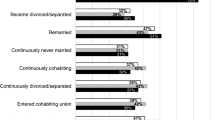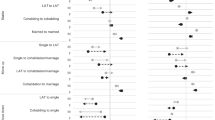Abstract
As the traditional nuclear family gives way to diverse couple types, questions regarding planning and satisfaction within relationships can be applied to partnerships outside of traditional marriages. The levels of interdependence in retirement planning and timing were investigated across three couple types: married heterosexual couples, cohabiting heterosexual couples, and lesbian couples. Analyses suggested that although all couples were interdependent in their retirement plans, this may be particularly the case for lesbian couples’ financial planning. In addition, relationship satisfaction was significantly associated with retirement lifestyle planning, but more so for lesbian couples than for heterosexual couples. The results are discussed in terms of gender, couple dynamics, and the social structures inherent in the three different couple types.

Similar content being viewed by others
Notes
In year 2000 US Census results, the percentage of married-couple households with children under 18 declined to 23.5% of all households in 2000 from 25.6% in 1990, and from 45% in 1960 (Schmitt 2001). Additionally, in the 2000 Census 601,209 households were headed by same-sex unmarried partners (Human Rights Campaign Census Report 2000). Because 3 to 8% of adults have predominantly same-sex attractions (Laumann et al. 1994), roughly 4,000,000 Americans who will be over the age of 65 by 2030 are likely to be same-sex attracted.
An additional study was conducted to examine correlates of the financial planning scale further. With a sample of 55 adults (age, M = 39.27, SD = 10.99; 47% women), the financial planning scale was moderately correlated with both percentile rating of a comparison of one’s financial planning to one’s peers where 0 = lowest and 100 = highest, r = .43, p < .05, and to objective retirement planning behavior, in particular, discussing financial planning with an accountant or retirement planning specialist, r = .46, p < .05. In a linear regression model, participants’ percentile rating of their financial planning and discussing financial planning with an accountant accounted for 23% of the variance of the financial planning variable, adjusted R 2 = .23, F = 8.42, p < .01.
To calculate pairwise intraclass correlations, data for both partners in each relationship were organized in a vertically parallel fashion. For heterosexual couples, data for women were grouped in one column and for men in another. However, for the same-sex couples, partners were randomly assigned to one side of the data set or the other, and were referred to in the descriptive statistics as Partner A and Partner B.
References
Blumstein, P., & Schwarz, P. (1983). American couples: Money, work, sex. New York: Morrow.
Brines, J., & Joyner, K. (1999). The ties that bind: Principles of cohesion in cohabitation and marriage. American Sociological Review, 64, 333–335.
Bryk, A. S., & Raudenbush, S. W. (1992). Hierarchical linear models: Applications and data analysis methods. Newbury Park, CA: Sage.
Clarkberg, M., Stolzenberg, R. M., & Waite, L. J. (1995). Attitudes, values, and entrance into cohabitational versus married unions. Social Forces, 74, 609–632.
Cohen, J., & Cohen, P. (1983). Applied multiple regression/correlation analysis for the behavioral sciences. Hillsdale, NJ: Erlbaum.
Cross, S. E., & Madson, L. (1997). Models of the self: Self-construals and gender. Psychological Bulletin, 122, 5–37.
Davey, A., & Szinovacz, M. E. (2004). Dimensions of marital quality and retirement. Journal of Family Issues, 25, 431–464.
Dennis, H., & Migliaccio, J. (1997). Redefining retirement: The baby boomer challenge. Generations, 2, 45–50.
Dolan, E. M., & Stum, M. S. (1998). Economic security and financial management issues facing same-sex couples. Journal of Family and Economic Issues, 19, 343–365.
Eagly, A. H. (1987). Sex differences in social behavior: A social role interpretation. Hillsdale, NJ: Earlbaum.
Ginn, J., & Arber, S. (1996). Patterns of employment, gender and pensions: The effect of work history on older women’s non-state pensions. Work, Employment & Society, 10, 469–490.
Gonzalez, R., & Griffin, D. (1997). On the statistics of interdependence: Treating dyadic data with respect. In S. W. Duck, K. Dindia, W. Ickes, R. Milardo, R. Mills, & B. Sarason (Eds.), Handbook of personal relationships (2nd ed., pp. 271–302). Chichester, UK: Wiley.
Gonzalez, R., & Griffin, D. (2000). On the statistics of interdependence: Treating dyadic data with respect. In W. Ickes & S. Duck (Eds.), The social psychology of personal relationships (pp. 181–213). Chichester, UK: Wiley.
Green, R. J., Bettinger, M., & Zacks, E. (1996). Are lesbian couples fused and gay male couples disengaged? Questioning gender straightjackets. In J. Laird & R. Green (Eds.) Lesbians and gays in couples and families: A handbook for therapists (pp. 185–230). San Francisco, CA: Jossey-Bass.
Han, S. K., & Moen, P. (1999). Clocking out: Temporal patterning of retirement. American Journal of Sociology, 105, 191–236.
Henkens, K. (1999). Retirement intentions and spousal support: A multi-actor approach. Journal of Gerontology: Social Sciences, 54B, S1–S19.
Henretta, J. C., O’Rand, A. M., & Chan, C. G. (1993). Joint role investments and synchronization of retirement: A sequential approach to couples’ retirement timing. Social Forces, 71, 981–1000.
Human Rights Campaign Census Report. (2000). Gay and lesbian families in the united states: Same-sex unmarried partner households. A preliminary analysis of 2000 United States census data. Washington, DC: Human Rights Campaign.
Kurdek, L. A. (1993). The allocation of household labor in gay, lesbian, and heterosexual married couples. Journal of Social Issues, 49, 127–139.
Kurdek, L. A. (1998). Relationship outcomes and their predictors: Longitudinal evidence from heterosexual married, gay cohabiting, and lesbian cohabiting couples. Journal of Marriage and the Family, 60, 553–568.
Kurdek, L. A., & Schmitt, J. P. (1986). Relationship quality of partners in heterosexual married, heterosexual cohabiting, and gay and lesbian relationships. Journal of Personality and Social Psychology, 51, 711–720.
Laumann, E., Gagnon, J. H., Michael, R. T., & Michaels, S. (1994). The social organization of sexuality: Sexual practices in the United States. Chicago, IL: University of Chicago Press.
Luke, D. (2004). Multilevel modeling. Thousand Oaks, CA: Sage.
Mackey, R. A., Diemer, M. A., & O’Brien, B. A. (2000). Psychological intimacy in the lasting relationships of heterosexual and same-gender couples. Sex Roles, 43, 201–227.
Manning, W. D., & Smock, P. J. (2002). First comes cohabitation then comes marriage? A research note. Journal of Family Issues, 23, 1065–1087.
Mock, S. E., & Cornelius, S. W. (2001). Couples’ retirement planning and timing: A life course analysis of diverse couple types (Working Paper 02–15). Ithaca, NY: Cornell University, Bronfenbrenner Life Course Center.
Moen, P. (1996). A life course perspective on retirement, gender, and well-being. Journal of Occupational Health Psychology, 1, 131–144.
Moen, P. (2001). The career quandary. Washington, DC: Population Reference Bureau.
Moen, P., Kim, J. E., & Hofmeister, H. (2001a). Couples’ work/retirement transitions, gender, and marital quality. Social Psychology Quarterly, 64, 55–71.
Moen, P., Sweet, S., & Swisher, R. (2001b). Customizing the career clock: Retirement planning and expectations (Working Paper 01–08). Ithaca, NY: Cornell University, Bronfenbrenner Life Course Center.
Moen, P., Sweet, S., & Townsend, B. (2001c). Appendix B: Characteristics of participants. In P. Moen, S. Sweet, & B. Townsend (Eds.), How family friendly is upstate New York? (pp. 103–106). Ithaca, NY: Cornell University, Cornell Employment and Family Careers Institute.
O’Rand, A. M., Henretta, J. C., & Krecker M. L.(1992). Family pathways to retirement. In M. Szinovacz, Maximiliane, & D. J. Ekerdt (Eds.), Families and retirement (pp. 81–98). Thousand Oaks, CA: Sage.
Peplau, L. A. (1991). Lesbian and gay relationships. In J. C. Gonsiorek & J. D. Weinrich (Eds.), Homosexuality: Research implications for public policy (pp. 177–196). Thousand Oaks, CA: Sage.
Prenda, K. M., & Lachman, M. E. (2001). Planning for the future: A life management strategy for increasing control and life satisfaction in adulthood. Psychology and Aging, 16, 206–216.
Quick, H. E., & Moen, P. (1998). Gender, employment, and retirement quality: A life course approach to the differential experiences of men and women. Journal of Occupational Health Psychology, 3, 44–64.
Raudenbush, S. W., Bryk, A. S., & Congdon, R. (2004). HLM (Version 6) [Computer software]. Lincolnwood, IL: Scientific Software International.
Rutter, V., & Schwartz, P. (2000). Gender, marriage, and diverse possibilities for cross-sex and same-sex pairs. In D. H. Demo, K. R. Allen, & M. A. Fine (Eds.), Handbook of family diversity (pp. 59–81). New York: Oxford University Press.
Schmitt, E. (2001). For first time, nuclear families drop below 25% of households. New York Times, A1, A41, May 15.
Smith, D. B., & Moen, P. (1998). Spousal influence on retirement: His, her, and their perceptions. Journal of Marriage and the Family, 60, 734–744.
Smith, D. B., & Moen, P. (2004). Retirement satisfaction for retirees and their spouses: Do gender and the retirement decision-making process matter? Journal of Family Issues, 25, 262–285.
Smock, P. J. (2000). Cohabitation in the United States: An appraisal of research themes, findings, and implications. Annual Review of Sociology, 26, 1–20.
Sprecher, S., & Felmlee, D. (1997). The balance of power in romantic heterosexual couples over time from “his” and “her” perspectives. Sex Roles, 37, 361–379.
Szinovacz, M., & DeViney, S. (2000). Marital characteristics and retirement decisions. Research on Aging, 22, 470–498.
Szinovacz, M. E., DeViney, S., & Davey, A. (2001). Influences of family obligations and relationships on retirement: Variations by' gender, race, and marital status. Journal of Gerontology, 56B(1), S20–S27.
Acknowledgements
This research was supported by the Alfred P. Sloan Foundation grant #FDN 99-6-9 and grant #99-6-3, Phyllis Moen, Principal Investigator. We gratefully acknowledge the Cornell Career’s Institute without which this research would not have been possible. We also thank Phyllis Moen, Natasha Kirkham, Richard Eibach, Sarah Watamura, Catherine Bradshaw, Makeeba Parramore Wilbourn, and Jen Brown for helpful and insightful comments during all phases of this research.
Author information
Authors and Affiliations
Corresponding author
Rights and permissions
About this article
Cite this article
Mock, S.E., Cornelius, S.W. Profiles of Interdependence: The Retirement Planning of Married, Cohabiting, and Lesbian Couples. Sex Roles 56, 793–800 (2007). https://doi.org/10.1007/s11199-007-9243-z
Published:
Issue Date:
DOI: https://doi.org/10.1007/s11199-007-9243-z




